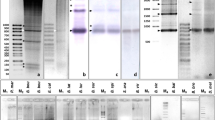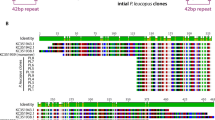Abstract
Three DNA probes isolated from three species ofReithrodontomys (R. montanus, R. megalotis, R. fulvescens) were used to examine within and among species variation in the chromosomal location of satellite DNA and constitutive heterochromatin. These probes hybridized to the centromeric regions on all chromosomes in six species of the subgenusReithrodontomys. Additionally, nearly all extra-centromeric C-band positive regions (with the exception of some heterochromatic material on the X and Y) hybridized to these probes. Within the subgenusReithrodontomys both the chromosomal distribution and organization of satellite DNA has changed throughout evolution. The evolutionary transition has been from a totally centromeric position inR. fulvescens to centromeric and non-centromeric regions in other species that have undergone extensive chromosomal rearrangements from the primitive karyotype for peromyscine rodents. In addition, the monomer repeat of the satellite sequence differs betweenR. fulvescens (monomer defined by PstI) and the remaining species in the subgenusReithrodontomys (monomer defined by EcoRI). These results suggest at least two amplification events for this satellite DNA sequence. Models and mechanisms concerned with the homogenization and spread of satellite sequences in complex genomes are evaluated in light of theReithrodontomys data. From a phlyogenetic standpoint, the satellite sequences composing heterochromatic regions were restricted to the subgenusReithrodontomys, which supports morphological differences used to recognize two subgenera,Reithrodontomys andAporodon. Probes failed to hybridize to any part of the karyotype ofR. mexicanus (subgenusAporodon) or to seven species from other closely related genera (Baiomys, Neotoma, Nyctomys, Ochrotomys, Onychomys, Peromyscus, Xenomys), some of which are considered as potential sister taxa forReithrodontomys.
Similar content being viewed by others
References
Arnason U (1974) Comparative chromosome studies in Cetacea. Hereditas 77:1–36
Arnheim N, Krystal M, Schmickel R, Wilson G, Ryder O, Zimmer E (1980) Molecular evidence for genetic exchange among ribosomal genes on nonhomologous chromosomes in man and apes. Proc Natl Acad Sci USA 77:7323–7327
Arrighi FE, Stock AD, Pathak S (1976) Chromosomes ofPeromyscus (Rodentia, Cricetidae) V. Evidence of pericentric inversions. Chromosomes Today 5:323–329
Baker RJ, Barnett RK (1981) Karyotypic orthoselection for additions of heterochromatic short arms in grasshopper mice (Onychomys: Cricetidae). Southwest Nat 26:125–131
Baker RJ, Barnett RK, Greenbaum IF (1979) Chromosomal evolution in grasshopper mice (Onychomys, Cricetidae). J Mamm 60:297–306
Baker RJ, Bickham JW (1980) Karyotypic evolution in bats: evidence of extensive and conservative chromosomal evolution in closely related taxa. Syst Zool 29:239–252
Baker RJ, Bickham JW (1984) Karyotypic megaevolution by another name: A response to Marks. Syst Zool 33:339–341
Baker RJ, Qumsiyeh MB (1988) Methods in Chiropteran mitotic chromosomal studies. In: Kunz TH (ed) Ecological and behavioral methods for the study of bats. Smithsonian Institution Press, pp 425–435
Baker RJ, Qumsiyeh MB, Hood CS (1987) Role of chromosomal banding patterns in understanding mammalian evolution. In: Genoways HH (ed) Current mammalogy, vol I. Plenum Publishing Corporation, pp 67–96
Baker RJ, Qumsiyeh MB, Rautenbach IL (1988) Evidence for eight tandem and five centric fusions in the evolution of the karyotype ofAethomys namaquensis A Smith. Genetica 76:161–169
Batistoni R, Vignali R, Negroni A, Cremisi F, Barsacchi-Pilone G (1986) A highly repetitive DNA family is dispersed in small clusters throughout theTriturus genome. Cell Biol Int Rep 10:486
Bingham P, Levis R, Rubin GM (1981) Cloning of DNA sequences from the white locus ofD. melanogaster by a novel and general method. Cell 25:693–704
Britten RJ, Kohne DE (1966) Nucleotide sequence repetition in DNA. Carnegie Inst Wash Year Book 67:78–106
Britten RJ, Kohne DE (1968) Repeated sequences in DNA. Science 161:529–540
Brutlag DL (1980) Molecular arrangement and evolution of heterochromatin. Annu Rev Genet 14:121–144
Carleton MD, Myers P (1979) Karyotypes of some harvest mice, genusReithrodontomys. J Mamm 60:307–313
Chomczynski P, Qasba PK (1984) Alkaline transfer of DNA to plastic membrane. Biochem Biophys Res Commun 122:340–344
Comings DE (1980) Arrangement of chromatin in the nucleus. Hum Genet 53:131–143
Cremisi F, Vignali R, Batistoni R, Barsacchi G (1988) Heterochromatic DNA inTriturus (Amphibia, Urodela) II. A centromeric satellite DNA. Chromosoma 97:204–211
Dover GA (1982) Molecular drive: A cohesive mode of species evolution. Nature 299:111–117
Engstrom MD, Bickham JW (1982) Chromosome banding and phylogenetics of the golden mouse,Ochrotomys nuttalli. Genetica 59:119–126
Engstrom MD, Dowler RC, Rogers DS, Schmidly DJ, Bickham JW (1981) Chromosomal variation within four species of harvest mice (Reithrodontomys). J Mamm 62:159–164
Feinberg AP, Vogelstein B (1983) A technique for radiolabeling DNA restriction endonuclease fragments to high specific activity. Anal Biochem 132:6–13
Feinberg AP, Vogelstein B (1984) A technique for radiolabeling DNA restriction endonuclease fragments to high specific activity. Anal Biochem 137:266–267
Flavell RR (1986) Repetitive DNA and chromosome evolution in plants. Philos Trans R Soc Lond [Biol] 312:227–292
Haiduk MW, Sanchez-Hernandez C, Baker RJ (1988) Phylogenetic relationships ofNyctomys andXenomys to other Cricetine genera based on data from G-banded chromosomes. Southwest Nat 33:397–403
Hazen MW, Arrighi FE, Johnston DA (1977) Chromosomes ofPeromyscus (Rodentia, Cricetidae) VIII. Genome characterization of four species. Chromosomes Today 6:167–176
Hood CS, Robbins LW, Baker RJ, Shellhammer HS (1984) Chromosomal studies and evolutionary relationships of an endangered species,Reithrodontomys raviventris. J Mamm 65:655–667
Hooper ET (1952) A systematic review of the harvest mice (GenusReithrodontomys) of Latin America. Misc Publ Mus Zool, Univ Michigan 77:1–255
Howell AH (1914) Revisions of the American harvest mice (genusReithrodontomys). N Am Fauna 36:1–97
Hsu TC, Arrighi FE (1971) Distribution of constitutive heterochromatin in mammalian chromosomes. Chromosoma 34:243–253
Jackson JA, Fink GR (1981) Gene conversion between duplicated genetic elements in yeast. Nature 292:306–311
John B (1988) The biology of heterochromatin. In: Verma RS (ed) Heterochromatin: Molecular and structural aspects. Cambridge Press, New York, pp 1–147
John B, Miklos GCG (1979) Functional aspects of satellite DNA and heterochromatin. Int Rev Cytol 58:1–114
John B, King M, Schweizer D, Mendelak M (1985) Equilocality of heterochromatin distribution and heterochromatin heterogeneity. Chromosoma 91:185–200
Johnson GD, Araujo GM (1981) A simple method of reducing the fading of immunofluorescence during microscopy. J Immunol Methods 43:349–350
Klein HL, Petes TD (1981) Intrachromosomal gene conversion in yeast. Nature 289:144–148
Koop BF, Baker RJ, Haiduk MW, Engstrom MD (1984) Cladistical analysis of the primitive G-band sequence for the karyotype of the ancestor of the Cricetidae complex of rodents. Genetica 64:199–208
Krystal M, Eustachio PB, Ruddle FH, Arnheim N (1978) Human nucleolus organizers on nonhomologous chromosomes can share the same ribosomal gene variants. Proc Natl Acad Sci USA 78:5744–5748
Lee MR, Elder FFB (1980) Yeast stimulation of bone marrow mitosis for cytogenetic investigations. Cytogenet Cell Genet 26:36–40
Macgregor HC, Sessions SK (1986) The biological significance of variation in satellite DNA and heterochromatin in newts of the genusTriturus: an evolutionary perspective. Philos Trans R Soc Lond Ser [Biol] 312:243–259
Macgregor HC, Sherwood S (1979) The nucleolus organizers ofPlethodon andAneides located by in situ nucleic acid hybridization withXenopus 3H ribosomal RNA. Chromosoma 72:271–280
Maniatis T, Fritsch EK, Sambrook J (1982) Molecular cloning: A laboratory manual. Cold Spring Harbor Laboratory, Cold Spring Harbor, New York
Mascarello JT, Hsu TC (1976) Chromosome evolution in woodrats, genusNeotoma (Rodentia: Cricetidae). Evolution 30:152–169
Macarello JT, Mazrimas JA (1977) Chromosomes of antelope squirrels (genusAmmospermophilus): A systematic banding analysis of four species with unusual constitutive heterochromatin. Chromosoma 64:207–217
Miller JH (1972) Experiments in molecular genetics. Cold Spring Harbor Laboratory, Cold Spring Harbor, New York
Moyzis RK, Albright KL, Bartholdi MF, Cram LS, Deaven LL, Hildebrand CE, Josta NE, Longmire JL, Meyne J, Robinson TS (1987) Human chromosome-specific repetitive DNA sequences: Novel markers for genetic analysis. Chromosoma 95:375–386
Moyzis RK, Buckinham JM, Cram LS, Deaven LL, Jones MD, Meyne J, Ratliff RL, Wu JR (1988) A highly conserved repetitive DNA sequence (TTAGGG)n, present at the telomeres of human chromosomes. Proc Natl Acad Sci USA 85:6622–6626
Nelson K, Baker RJ, Shellhammer HS, Chesser RK (1984) Test of alternative hypotheses concerning the origin ofReithrodontomys raviventris: genetic analysis. J Mamm 65:668–673
O'Brien SJ, Seuanez HN, Womack JE (1985) On the evolution of genome organization in mammals. In: MacIntyre RS (ed) Molecular evolutionary genetics. Plenum Press, New York, pp 519–589
Pathak S, Hsu TC, Arrighi FE (1973) Chromosomes ofPeromyscus (Rodentia, Cricetidae), IV. The role of heterochromatin in karyotypic evolution. Cytogenet Cell Genet 12:315–326
Peacock WJ, Appels R, Dunsmuir R, Lohe AR, Gerlach WL (1977) Highly repeated DNA sequences: Chromosomal localisation and evolutionary conservatism. In: Brinkley BR, Porter KR (eds) International Cell Biology. Rockefeller Univ Press, New York, pp 494–506
Rabl C (1885) Über Zelltheilung. Morp Jahrb 10:214–330
Robbins LW, Baker RJ (1980) G- and C-banded studies on the primitive karyotype forReithrodontomys. J Mamm 61:708–714
Robbins LW, Baker RJ (1981) An assessment of the nature of chromosomal rearrangements in 18 species ofPeromyscus (Rodentia: Cricetidae). Cytogenet Cell Genet 31:194–202
Saumweber H (1987) Arrangement of chromosomes in interphase cell nuclei. In: Henning W (ed) Results and problems in cell differentiation 14, Structure and function of eukaryotic chromosomes. Springer-Verlag, Berlin, pp 227–234
Schweizer D, Ehrendorfer F (1983) Evolution of C-band patterns in Asteraceae-Anthemideae. Biol Zentralb 102:637–655
Schweizer D, Loidl L, Hamilton B (1987) Heterochromatin and the phenomenon of chromosome banding. In: Hennig W (ed) Results and problems in cell differentiation 14, Structure and function of eukaryotic chromosomes. Springer-Verlag, Berlin, pp 235–254
Shellhammer HS (1967) Cytotaxanomic studies of the harvest mice of the San Francisco Bay region. J Mamm 48:549–556
Singer MF (1982) Highly repeated sequences in mammalian genomes. Int Rev Cyt 76:67–112
Skinner DM (1977) Satellite DNAs. Bioscience 27:790–796
Smith GP (1974) Unequal crossover and the evolution of multigene families. Cold Spring Harbor Symp Quant Biol 38:507–513
Smith GP (1976) Evolution of repeated DNA sequences by unequal crossover. Science 191:528–535
Smith GP (1978) What is the origin and evolution of repetitive DNAs? Trends Biochem Sci 3:34–36
Southern EH (1975) Detection of specific sequences among DNA fragments separated by gel electrophoresis. J Mol Biol 98:503–517
Stock AD (1974) Chromosome evolution in the genusDipodomys and its taxonomic and phylogenetic implications. J Mamm 55:505–526
Sumner AT (1972) A simple technique for demonstrating centromeric heterochromatin. Exp Cell Res 75:304–306
Walsh JB (1987) Persistence of tandem arrays: Implications for satellite and simple-sequence DNAs. Genetics 115:553–567
Weinand U, Schwarz Z, Felix G (1979) Electrophoretic elution of nucleic acids from gels adapted for subsequent biological tests. Application for analysis of mRNAs from maize endosperm. FEBS Lett 98:319–323
Yates TL, Baker RJ, Barnett RK (1979) Phylogenetic analysis of karyological variation in three genera of Peromyscine rodents. Syst Zool 28:40–48
Author information
Authors and Affiliations
Rights and permissions
About this article
Cite this article
Hamilton, M.J., Honeycutt, R.L. & Baker, R.J. Intragenomic movement, sequence amplification and concerted evolution in satellite DNA in harvest mice,Reithrodontomys: Evidence from in situ hybridization. Chromosoma 99, 321–329 (1990). https://doi.org/10.1007/BF01731719
Received:
Revised:
Accepted:
Issue Date:
DOI: https://doi.org/10.1007/BF01731719




